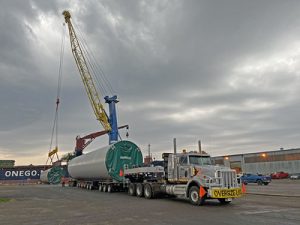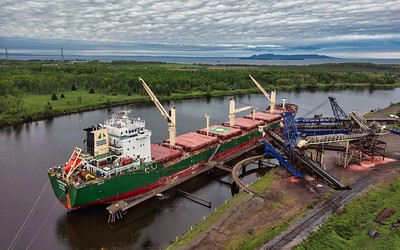Farming-Related Exports Drive Great Lakes-Seaway Shipping Activity in June
Exports buoyed shipping activity through the St. Lawrence Seaway in June, with U.S. coke and Canadian potash heading to overseas destinations for the season reaching a 20-year record high. Canadian ports also reported strong demand for Ontario-grown soybeans and corn exports along with rebounding domestic salt and petroleum shipments.
Overall cargo tonnage shipments (from March 22 to June 30) via the St. Lawrence Seaway totaled 11.9 million metric tons, while down 8.3% compared to 2021, significantly closing the gap in comparison to April, when tonnage was down 18% following the start to the season.
“Canada’s Eastern maritime trade corridor continues to prove month after month that it is a resilient, reliable and sustainable export route for farmers and businesses during these uncertain times,” said Terence Bowles, president and CEO of The St. Lawrence Seaway Management Corporation. “Some of these products, such as grain and potash, are helping to alleviate global shortages that have been caused by the Russian/Ukraine war.”
The Port of Thunder Bay, the only potash export port on the Great Lakes-Seaway System, reported that year-to-date shipments of potash have already exceeded the port’s annual average. Consequently, Prairie potash shipments through the Seaway (from March 22 to June 30) totaled 376,000 metric tons, up 282% compared to last year. The potash, a key ingredient in fertilizer, was destined for Europe, South America and North Africa.

Although overall Canadian grain volumes through the Seaway are down 21% due to last year’s smaller Prairie crop — there continues to be strong demand for Ontario-grown grain.
In June, a large number of containers of locally-grown soybeans were loaded onto a Spliethoff vessel at the Ramey’s Bend terminal in Port Colborne for export to Europe.
“This local agricultural exporter had traditionally used a combination of trucking and rail to a container port but was looking for an alternative solution to bypass some of the backlog in the supply chain,” said Frank Montecalvo, vice-president of operations in Ontario for LOGISTEC, which manages the terminal on Seaway-owned land. “We had empty containers available from previous imports into the Niagara region and were able to provide a simpler, more direct to marine option for them by eliminating the rail leg to the coast. The move really showcases the potential of the Great Lakes-Seaway system to alleviate congestion and provide more efficient alternatives for the region’s businesses.”
At the Port of Hamilton, year-to-June 30 shipments of grain are up 28% compared to last year.
“We continue to see strong exports of Ontario-grown grain and soybeans, at a time when Canadian grain can make a positive contribution to global food security. As of June, 1 million metric tons of grain had been shipped through the Port of Hamilton,” said Ian Hamilton, CEO of HOPA Ports, adding that a new $30m infrastructure investment program was also announced in June, supported by the National Trade Corridors Fund, (NTCF) which will create new capacity at the Port of Oshawa for the export of Ontario grain by growers east of Toronto.
The Port of Windsor has recovered significant ground with year-to-date cargo volumes now totaling 1.8 million tons, down 5% but a major improvement from the start of the season when volumes were down 15%. Grain volumes continue to be a bright spot with soya and corn exports in high demand; and aggregate shipments rebounding after a slow start due to spring ice and winter conditions at quarries. Salt shipments have fully rebounded as the Windsor Salt mine’s production is now exceeding 2021 following the creation of a new seam. The Essex Terminal Railway Company and its sister company Morterm, which operates the port’s only cargo and breakbulk facility, also announced earlier this month a $11 million infrastructure project, including $5 million from the NTCF, to build a new warehouse to increase capacity and improve the efficiency of moving high-quality, automotive-grade steel from ship to rail.
The overall shipping season is also being buoyed by a 35% rise in refined liquid bulk products such as jet fuel, diesel and gasoline, being transported through the St. Lawrence Seaway on domestic tankers to cities in Ontario, Quebec and Eastern Canada.
“The summer holiday season is certainly in full swing. We saw a significant increase in shipments in June to supply jet fuel, diesel and gasoline to meet the demand for air travel and road trips, particularly in the Greater Toronto region and Eastern Canada,” said Julie Lambert, president of Petro-Nav Ltd., which has eight domestic tankers. “The window to supply crucial cargoes such as petroleum products to Arctic communities by ship is also from July to end of September. Our Arctic communities depend on a steady supply of these products throughout the year, so timely delivery within the navigation period is critical. Our regular Arctic program coupled with the strong domestic lakes market are keeping our ships fully employed over the next few months.”

Winding Down
As the Great Lakes-St. Lawrence Seaway System approaches its seasonal closure, the rhythm of maritime commerce slows. The Montreal–Lake Ontario section will cease transits after December 24, with all ships required to clear... Read More

Algoma Steel to Lay Off 1,000 Workers, Close Blast Furnace
Algoma Steel plans to lay off about 1,000 workers and close its blast furnace and coke making operations in early 2026. Algoma cites the high tariffs imposed by U.S. President... Read More


